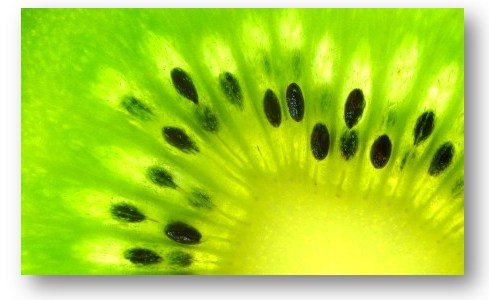People are attracted to kiwi fruit because of it’s brilliant green color and exotic taste but the real uniqueness of kiwi comes from its health benefits. Read it’s 14 health benefits, interesting facts and how to use.
14 Health Benefits
1. Helps Your Digestions with Enzymes
Raw kiwi contains actinidain, a protein dissolving enzyme that can help digest a meal much like the papain in papaya or bromelain in pineapple.
2. Helps Manage Blood Pressure
The high level of potassium helps keep our electrolytes in balance by counteracting the effects of sodium.
3. Protection of DNA Damage
A study by Collins, Horska and Hotten showed that the unique combination of antioxidants in Kiwi fruit helps protect the cell DNA from oxidative damage. Some experts conclude this can help prevent cancer.
4. Boosts Your Immunity
Kiwi’s high vitamin C content along with other antioxidant compounds has been proven to boost your immune system.
5. Protects Against Macular Degeneration and Other Eye Problems
Macular degeneration is the leading cause of vision loss in older adults. A study on over 110,000 men and  women showed that eating 3 or more serving of fruit per day decreased macular degeneration by 36%.  This is thought to be associated with high levels of lutein and zeaxanthin, natural chemicals found in the human eye. Although both fruits and vegetables were studied, this same effect was not shown for vegetables.
6. Digestive Health
Kiwis are a great source of fiber. This prevents constipation and other intestinal problems.
7. Helps Clean Out Toxins
The fuzzy fiber of Kiwi helps bind and move toxins from your intestinal tract.
8. Helps Fight Heart Disease
Eating 2-3 kiwis a day has been shown to reduce the potential of blood clotting by 18% and reduced triglycerides by 15%. Many individuals take aspirin to reduce blood clotting but this causes many side effects including inflammation and intestinal bleeding. Kiwi fruit has same anti-clotting benefits with the only side effect being all the other health benefits mentioned.
9. Suitable For Diabetics
Kiwi is in the ‘low’ category for glycemic index meaning it does not raise your blood sugar quickly. It also has a glycemic load of ‘4’ which means it is OK for diabetics.
10. Smart Carb for Weight Loss
Kiwi’s low glycemic index and high fiber content means it will not create the strong insulin rush as other fruit with high sugar contents so the body will not respond by storing fat.
11. Create Alkaline Balance
Kiwi is in the ‘most alkaline’ category for fruits which means it has a rich supply of minerals to replace the excess of acid foods most individuals consume. A few of the benefits of a properly acid/alkaline balanced body are: youthful skin, deeper sleep, abundant physical energy, fewer colds, less arthritis and reduced osteoporosis.
12. Great for the Skin
Kiwis are a good source of vitamin E, an antioxidant known to protect skin from degeneration.
13. Exotic Taste and Look for Food Variety
Kiwis LOOK and TASTE GREAT. Kids love them because they are so different from most fruits.
For nutritional balance it is always good to eat a variety of foods. Each food has its own unique qualities and powers. The trouble with most people’s diet is that we eat such a limited number of foods. It increases the chances of not getting enough of some important nutrient.
14. Naturally Organic
Kiwi fruit is on the list of foods that generally are safe from a lot of pesticide residues.  For 2012 it came in with the top 10 safest foods. OF course it is always good to support organic when you can as a matter of principle– it’s good to know that there is not a big danger if organic is not available or viable for you.
Interesting Facts
- Kiwi fruit was named after the New Zealand Kiwi bird – an unusual flightless bird.- because they are both small, brown and furry.
- Not all kiwi fruit is fuzzy! The most popular species of kiwifruit is appropriately called Fuzzy Kiwifruit but there is also Golden Kiwi with a smooth bronze skin. Â The Golden Kiwi is actually sweeter and more aromatic in flavor
- Although Kiwi’s have been native to China for centuries, practically no one in North knew what they were 50 years ago. They were first introduced to the US in 1962.  They caught on fast!
- Although kiwifruit can grow in any temperate climate, most of the world kiwi for commercial use is grown in Italy, New Zealand and Chile. It is grown much like grapes.
- YES – you can eat the fuzz if you want.
How to Use:
- If a kiwi does not yield a bit to finger pressure, it can be ripened by storing it at room temperature away from the sun.
- This ripening can be hastened by putting it in a paper bag with a banana, apple or pear.
- Once a kiwi fruit is ripe, keep away from other a fruit (even in the refrigerator) since the kiwi is very sensitive to the ethylene gas given off by those other fruits and it will over ripen.
- The actinidain in raw kiwi makes them unsuitable for desserts and other dishes that are not eaten right away because it can make the dish too mushy or stop it from setting. This applies to proteins but also to other fruits.
Cautions:
Kiwifruit contain a measurable amount of oxalates, a naturally occurring substance in many plants and animals.  When oxalates become too concentrated in body fluids, they can crystallize and cause health problems. People with already existing and untreated kidney or gallbladder problems may therefore want to avoid eating kiwi. There is a lot of controversy about the amounts needed to be significant, particularly from plants.
Kiwi’s like avocados and bananas also contain enzyme substances associated with the latex-fruit allergy syndrome. If you have a latex allergy, you may be allergic to kiwi also. Since ripening the fruit with ethylene gas increases these substances; organic kiwi not treated with gas will have fewer allergy-causing compounds. Cooking also deactivates the enzymes.
Kiwi Recipes:
Fruity Tooty – Kiwi Smoothie
Alkalizing Fruit Salad with kiwi





